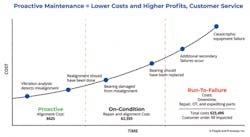Every week, I am physically inside plant sites or in contact with individuals on the plant floor. Last week was no exception, as a maintenance manager reached out for a conversation. From experience, you and I could probably have a similar discussion.
From the Plant Floor is a new monthly column that explores reliability challenges faced by organizations and solutions to overcome them.
He related that the corporate reliability manager left seven months ago due to a lack of support as executive management changed. The role remains vacant. The same lack of support trickles down into the plant where he works. Production consumes the available hours with little planned maintenance time allotted. He shifted resources to the limited available hours on the third shift for some lines. Other lines ran 24/6 with one weekend day left for maintenance.
Last week, he was informed that production would run on that one day, too, leaving him frustrated. He tried to convince management, without success, to approve more maintenance hours by using data that shows declining equipment availability. The organization is focused on capital expansions to add new lines to overcome the capacity constraints. This maintenance manager questions the need based on the “hidden plant” data.
Forward to another organization. The new production manager told the maintenance manager that failing maintenance metrics due to operating practices did not matter. He was accountable for meeting production targets, period. No doubt, this was an impactful message for someone who spent the last 10 years of his career building up a very successful proactive maintenance organization built on collaborative partnerships with engineering and production.
Having held both maintenance and production manager roles, I understand both sides. Manufacturing organizations fulfill a market need with products and must generate a profit. There are seemingly unprecedented opportunities to increase market share and profits in the current environment of constrained supply chains and inflated pricing. Groups like building product manufacturers are deferring maintenance and capital improvements on existing lines to produce everything possible to capitalize on current market pricing, acknowledging that equipment restoration costs will be potentially higher later.
Realize that businesses must make choices based on their tolerance for risk. If you consider the ability to gain exponentially higher profit versus the risk of losing $23,495, which would you choose? Many are choosing run-to-failure. The severity of the failure influences the organization’s tolerance for risk as safety, and environmental impacts lessen the risk tolerance compared to an operational impact like customer fulfillment.
When evaluating expectations for maintenance, businesses seek equipment availability and reliability (to the degree that maintenance influences reliability), lower costs, safety and environmental compliance, and higher quality. While equipment failures are often attributed wholly to maintenance, the root causes often reflect a low percentage. In Mobley’s Maintenance Engineering Handbook, 2nd Edition, a study indicates that 17% of failures were attributed to maintenance. From Ron Moore’s work, maintenance owns 10% of the loss of productivity measurement in the overall equipment effectiveness (OEE) metric.
So, where does that leave the maintenance function in terms of equipment access so maintenance can hold up its end of the equipment reliability equation? While the maintenance goal is to avoid or mitigate the consequences of failure, consider ways to partner to achieve the business results.
First, maintenance is responsible for educating the business partners (i.e., engineering, procurement, production, storeroom, and management) to help them make effective business choices based on risk using data.
Second, the maintenance function must focus on doing the right work at the right time and in the right way from a precision perspective. From reliability-centered maintenance (RCM) analyses, 40 to 60% of preventive maintenance activities fail to add value as the tasks don’t address the likely failure modes. Use equipment running on-condition inspections and predictive tools to find equipment in the act of failing where possible in order to reduce planned downtime windows. With upwards of 70% of failures being self-induced and 40% attributed to human error, maintenance must utilize standardized work. Surely, maintenance technicians can agree that there is one right way to perform sets of tasks within the site. Use precision task steps and techniques (i.e., laser alignment) in all maintenance procedures such as overhauls and corrective jobs to prevent the introduction of new defects.
Third, improve the accuracy of job estimates. Undoubtedly, job durations will vary with the individual doing the work and the conditions encountered on the job. Yet, excessive padding and ineffective job planning only worsen the maintenance-production partnership. Standardized work and training are factors.
Fourth, use advanced planning for future work with the materials kitted and staged to leverage unexpected downtime windows. Pull resources from other areas to work while the reactive crew addresses the downtime event. Look for short windows such as changeovers to do similar work.
Finally, while many do root cause activities on failures, few work the process thoroughly to identify the actual root causes, and even fewer fully implement the corrective actions. Don’t fall into that trap.
This story originally appeared in the January 2022 issue of Plant Services. Subscribe to Plant Services here.



